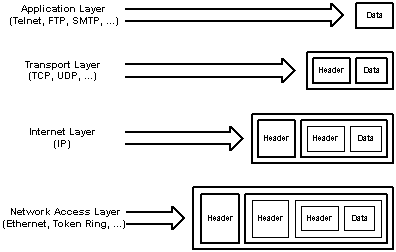The TCP/IP model does not exactly match the OSI model. There is no universal agreement
regarding how to describe TCP/IP with a layered model but it is generally agreed that there are
fewer levels than the seven layers of the OSI model. Most descriptions present from three
to five layers. In this technical reference document the layers of the TCP/IP model are
defined as follows:
- Application Layer
- In TCP/IP the Application Layer also includes the OSI Presentation
Layer and Session Layer. In this document an application is any process that occurs above
the Transport Layer. This includes all of the processes that involve user interaction.
The application determines the presentation of the data and controls the session. In
TCP/IP the terms socket and port are used to describe the path over which
applications communicate. There are numerous application level protocols in TCP/IP,
including Simple Mail Transfer Protocol (SMTP) and Post Office Protocol (POP) used for
e-mail, Hyper Text Transfer Protocol (HTTP) used for the World-Wide-Web, and File Transfer
Protocol (FTP). Most application level protocols are associated with one or more port
number.
- Transport Layer
- In TCP/IP there are two Transport Layer protocols. The Transmission
Control Protocol (TCP) guarantees that information is received as it was sent. The User
Datagram Protocol (UDP) performs no end-to-end reliability checks.
- Internet Layer
- In the OSI Reference Model the Network Layer isolates the upper
layer protocols from the details of the underlying network and manages the connections
across the network. The Internet Protocol (IP) is normally described as the TCP/IP Network
Layer. Because of the Inter-Networking emphasis of TCP/IP this is commonly referred to as
the Internet Layer. All upper and lower layer communications travel through IP as they are
passed through the TCP/IP protocol stack.
- Network Access Layer
- In TCP/IP the Data Link Layer and Physical Layer are normally
grouped together. TCP/IP makes use of existing Data Link and Physical Layer standards
rather than defining its own. Most RFCs that refer to the Data Link Layer describe how IP
utilizes existing data link protocols such as Ethernet, Token Ring, FDDI, HSSI, and ATM.
The characteristics of the hardware that carries the communication signal are typically
defined by the Physical Layer. This describes attributes such as pin configurations,
voltage levels, and cable requirements. Examples of Physical Layer standards are RS-232C,
V.35, and IEEE 802.3.
The four layer structure of TCP/IP is built as information is passed down from applications
to the physical network layer. When data is sent, each layer treats all of the information
it receives from the layer above as data and adds control information to the front of that
data. This control information is called a header, and the addition of a header
is called encapsulation. When data is received, the opposite procedure takes
place as each layer removes its header before passing the data to the layer above.

|
